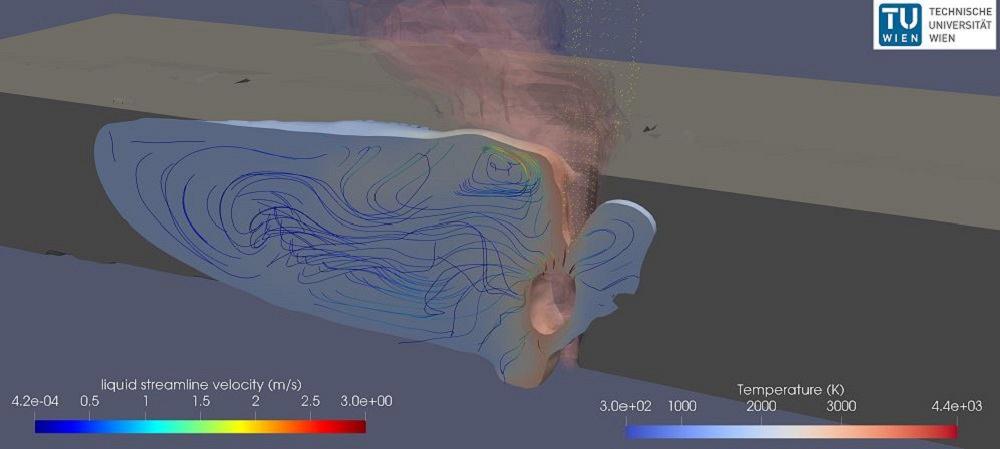- FMA
- The Fabricator
- FABTECH
- Canadian Metalworking
Categories
- Additive Manufacturing
- Aluminum Welding
- Arc Welding
- Assembly and Joining
- Automation and Robotics
- Bending and Forming
- Consumables
- Cutting and Weld Prep
- Electric Vehicles
- En Español
- Finishing
- Hydroforming
- Laser Cutting
- Laser Welding
- Machining
- Manufacturing Software
- Materials Handling
- Metals/Materials
- Oxyfuel Cutting
- Plasma Cutting
- Power Tools
- Punching and Other Holemaking
- Roll Forming
- Safety
- Sawing
- Shearing
- Shop Management
- Testing and Measuring
- Tube and Pipe Fabrication
- Tube and Pipe Production
- Waterjet Cutting
Industry Directory
Webcasts
Podcasts
FAB 40
Advertise
Subscribe
Account Login
Search
Civan, TU Wien collaborate on dynamic beam laser welding simulation
- March 4, 2022
- News Release
- Laser Welding
Laser experts at the Technical University Wien (TU Wien) in Vienna have collaborated with Jerusalem-based Civan Lasers to simulate its disruptive dynamic beam laser technology. As the first and only multiphysics simulation software capable of modeling the megahertz-level frequencies of Civan’s dynamic beam lasers (DBLs), the work improves understanding of how these beam-shaping lasers influence control of keyhole and melt-pool dynamics.
“The beam-shaping capability of Civan’s laser opens up new possibilities for increasing welding quality and speed in many of today’s challenging applications,” said Andreas Otto, professor at the Institute of Production Engineering and Photonic Technologies, TU Wien. “It's a really significant development that will shape the future of laser materials-processing technology and even open up the development of entirely new applications.”
Providing unique insight into the effect of each beam shape and frequency on keyhole and melt-pool dynamics, this simulation tool will play a critical role in process development, helping to optimize beam shape and frequency for a variety of laser materials-processing applications. Current simulations have focused on butt welding of stainless steel pipe with a gap. Future collaboration will target other welding, drilling, and surface treatment applications involving a variety of materials.
The welding of a stainless steel pipe in a butt joint configuration was particularly challenging. The finite precision in the cut pipe fronts plus limitations of the clamping system resulted in a small gap (from tens of microns to a few hundred microns). This welding process, which relied on standard static laser sources, did not use filler material, and the result was a gap at the contact line and low-quality weld seams.
To come up with a solution, Civan experimented with its DBL and then collaborated with TU Wien to simulate the process. The result was a better understanding of why certain shapes work better than others. The simulation also helped in the design of alternative beam shapes that might work for this problem and led to the development of general guidelines on how to design suitable beam shapes for such situations.
Civan’s patented coherent beam combination modulates beam shape as desired at megahertz frequencies, without any moving parts. Optical phased-array coherent beam combining merges many single-mode laser beams into one larger beam. Each laser emits its own light that overlaps with other beams in the far field to create a diffraction pattern that unlocks the flexibility needed to manipulate the beam shape in real time to create a DBL. By using phase modulators to control individual beams, the resulting interference pattern can be changed to maximize the beam spot position and produce various shape patterns inscribed by the beam's motion.
subscribe now

The Fabricator is North America's leading magazine for the metal forming and fabricating industry. The magazine delivers the news, technical articles, and case histories that enable fabricators to do their jobs more efficiently. The Fabricator has served the industry since 1970.
start your free subscription- Stay connected from anywhere

Easily access valuable industry resources now with full access to the digital edition of The Fabricator.

Easily access valuable industry resources now with full access to the digital edition of The Welder.

Easily access valuable industry resources now with full access to the digital edition of The Tube and Pipe Journal.
- Podcasting
- Podcast:
- The Fabricator Podcast
- Published:
- 04/16/2024
- Running Time:
- 63:29
In this episode of The Fabricator Podcast, Caleb Chamberlain, co-founder and CEO of OSH Cut, discusses his company’s...
- Trending Articles
AI, machine learning, and the future of metal fabrication

Employee ownership: The best way to ensure engagement

Steel industry reacts to Nucor’s new weekly published HRC price

Dynamic Metal blossoms with each passing year

Metal fabrication management: A guide for new supervisors

- Industry Events
16th Annual Safety Conference
- April 30 - May 1, 2024
- Elgin,
Pipe and Tube Conference
- May 21 - 22, 2024
- Omaha, NE
World-Class Roll Forming Workshop
- June 5 - 6, 2024
- Louisville, KY
Advanced Laser Application Workshop
- June 25 - 27, 2024
- Novi, MI


























